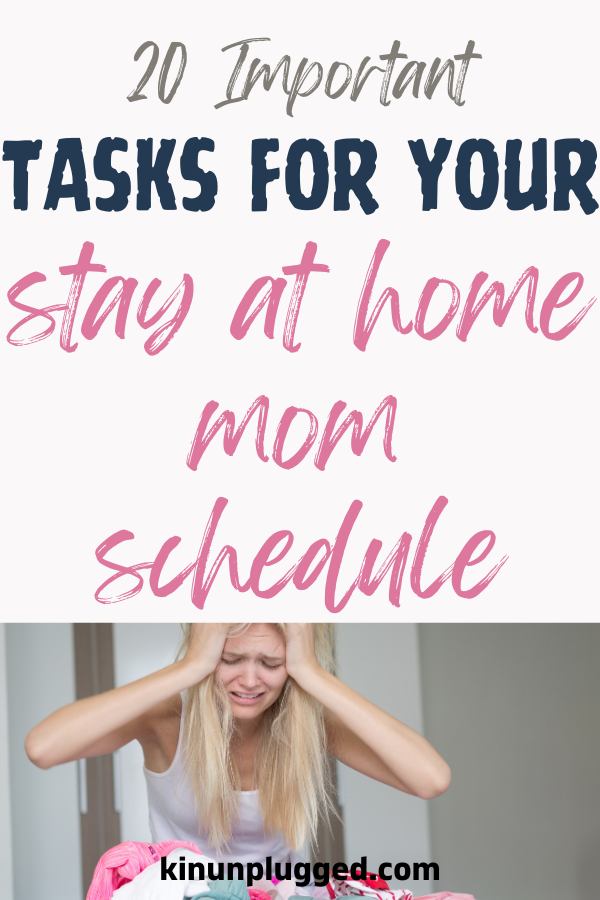It is so important to create a stay at home mom schedule primarily to maintain your sanity! Apart from that, like with anything else, failing to plan means planning to fail.
Your entire family also benefits from it both directly and indirectly. Mom/wife is sane as she has provided herself with some structure and the household is therefore far more in order than it would otherwise be.
In this article, you will find some benefits of creating a schedule for your life as a stay at home mom, the main things to consider in creating your schedule and also some sample schedules to suit your lifestyle.
READ: What do stay at home moms do all day?
The Benefits of a Stay-at-Home Mom Schedule

1. Reducing stress and chaos
- A well-structured schedule provides a sense of order and predictability to a stay-at-home mom’s day. It outlines tasks and activities, reducing the uncertainty that can lead to stress.
- Knowing what needs to be done and when helps moms allocate their time effectively, reducing the feeling of being overwhelmed by a never-ending to-do list.
- By having a designated time for chores, self-care and family activities, moms can minimize the chaos that often arises when tasks are left unorganized or rushed.
2. Improved time management and productivity
- A schedule encourages better time management by allocating specific time blocks for various tasks. This helps moms prioritize their responsibilities and allocate sufficient time to each.
- It fosters a sense of discipline and accountability. When moms stick to their schedules, they’re more likely to complete tasks efficiently, leading to increased productivity.
- Time management skills honed through a schedule can also benefit moms in other areas of life, such as pursuing personal interests, hobbies or part-time work.
3. Positive impact on children’s routines and development
- Children thrive on routines and consistency. A stay-at-home mom schedule establishes a daily rhythm that provides stability for kids.
- Predictable routines make it easier for children to understand expectations and transitions. For instance, they know when it’s time for meals, play, and bedtime.
- Schedules often include educational and enriching activities, which can support a child’s cognitive, emotional, and social development. Moms can plan age-appropriate activities, reading time, and outings that stimulate learning.
- Children also benefit from observing their mom’s organization and time management skills, which can serve as positive examples for them as they grow.
20 Important tasks for your stay at home mom schedule

Creating an effective stay-at-home mom schedule involves prioritizing tasks that cater to both the family’s needs and the mom’s well-being.
- Childcare. Caring for and nurturing children is the primary responsibility. This includes feeding, diaper changing, and engaging in age-appropriate activities.
- Household chores. Managing the household involves tasks like cleaning, laundry, cooking, and grocery shopping.
- Meal preparation. Planning and preparing meals for the family is a significant daily task.
- Personal time. Allocating time for self-care, relaxation, and pursuing personal interests is essential for a mom’s well-being.
- Family activities. Scheduling quality time for family bonding, such as outings, games, or storytime, is crucial for building strong family connections.
- Education and development. Planning activities that promote children’s education and development, like reading, educational games, and crafts.
- Appointment management. Managing doctor’s appointments, school events, and other family commitments is vital for staying organized.
- Exercise and physical activity. Incorporating physical activity into the daily routine to promote health and well-being.
- Social interaction. Setting aside time for social interaction, whether with other moms, friends, or support groups, is essential for mental and emotional health.
- Self-improvement. Pursuing personal growth and learning opportunities, such as online courses or hobbies, can help moms continue their development.
- Errands and administration. Managing household paperwork, bills, and running errands like banking or post office visits.
- Quiet time. Providing moments of quiet or rest, especially during children’s naptimes, allows moms to recharge.
- Planning and organization. Allocating time for scheduling and planning, ensuring a smooth flow of tasks.
- Flexible time. Including flexible time slots for handling unexpected events, emergencies, or changes in the routine.
- Bedtime routine. Establishing a consistent bedtime routine for children can help ensure restful sleep.
- Self-care. Prioritizing self-care activities like meditation, a relaxing bath, or skincare routines.
- Home maintenance. Scheduling time for home maintenance tasks like gardening, repairs, or decluttering.
- Hobbies and interests. Setting aside time for pursuing hobbies and interests that bring joy and fulfillment.
- Financial management. Managing the family budget, paying bills, and saving for the future.
- Quality time with partner. Ensuring that there’s time for a meaningful connection with a partner or spouse.
19 Things To Consider When Making Your Stay At Home Mom Schedule

Creating an effective stay-at-home mom schedule requires thoughtful consideration of various factors to ensure it meets both your family’s needs and your personal well-being. Here are important things to consider:
- Age and needs of kids: Tailor your schedule to the age and needs of your children. Infants and toddlers have different routines and demands than school-aged kids.
- Prioritize tasks: Identify your most important daily tasks and prioritize them. What are the non-negotiables that must be included in your schedule?
- Personal goals: Consider your personal goals and interests. Allocate time in your schedule for pursuing hobbies, self-improvement, or part-time work if desired.
- Family activities: Plan quality family time. Include activities that allow you to bond with your children and partner.
- Meals and nutrition: Plan meals and snacks, ensuring they are balanced and nutritious. Factor in grocery shopping and meal preparation time.
- Self-care: Prioritize self-care activities like exercise, relaxation, and self-reflection. A well-rested and happy mom is better equipped to care for her family.
- Routine vs. flexibility: Strike a balance between having a routine and allowing for spontaneity. A structured routine can provide stability, but it’s also important to have fun and go with the flow.
- Child’s development: Incorporate age-appropriate activities that promote your child’s development. This could include reading time, creative play, or educational games.
- Boundaries: Establish boundaries to ensure that you have dedicated time for yourself and your partner. Communicate these boundaries to your family.
- Support system: Consider your support system. Are there friends, family members, or babysitters who can provide assistance when needed?
- Time blocks: Organize your day into time blocks. Assign specific tasks and activities to each block to create structure.
- Daily goals: Set achievable daily goals. This helps you stay focused and provides a sense of accomplishment.
- Review and adjust: Periodically review your schedule and be willing to make adjustments as your family’s needs change or as you discover what works best for you.
- Delegate: Delegate tasks to family members when possible. Encourage children to take on age-appropriate responsibilities.
- Self-compassion: Be kind to yourself. Understand that not every day will go as planned, and that’s okay. Avoid perfectionism and embrace imperfections.
- Time for partner: Include quality time with your partner to maintain a strong relationship. Date nights or even simple conversations can help keep the connection alive.
- Me-time: Prioritize “me-time.” It’s essential for your mental and emotional well-being. Schedule activities that bring you joy and relaxation.
- Health and safety: Ensure that your schedule supports your family’s health and safety. This includes regular medical check-ups, safety precautions, and healthy routines.
- Communication: Communicate your schedule with your family. Let them know
How often should a stay-at-home mom go out?
The frequency with which a stay-at-home mom goes out varies depending on factors like personal preferences, family dynamics and children’s needs. Typically, daily outdoor time for both mom and children is beneficial, whether it’s a short walk or playtime. Social interaction through outings with friends or mom groups can be weekly or bi-weekly, while errands and activities are based on family schedules.
Date nights for partners and personal interests may occur monthly or as needed, and children’s extracurricular activities can also impact outings. The frequency should balance the mom’s needs with her caregiving responsibilities, adapting to family dynamics and individual preferences.
READ: Do stay-at-home moms need alone time?
Sample Daily Schedules For Stay-At-Home Moms

Here are sample daily schedules for stay-at-home moms at different stages of parenting, including variations for moms with part-time work or other responsibilities.
Sample Schedule for a Stay-at-Home Mom with an Infant (0-6 Months)
6:00 AM – Wake up and nurse/bottle-feed the baby
6:30 AM – Diaper change and playtime with gentle toys
7:00 AM – Morning nap for the baby
9:00 AM – Wake up and nurse/bottle-feed
9:30 AM – Tummy time and interactive play
11:00 AM – Mid-morning nap for the baby
12:30 PM – Wake up and nurse/bottle-feed
1:00 PM – Mom’s lunchtime while baby rests in a playpen
2:00 PM – Afternoon nap for both mom and baby
4:00 PM – Wake up and nurse/bottle-feed
4:30 PM – Snuggle and bonding time
6:00 PM – Evening nap for the baby while mom prepares dinner
7:00 PM – Baby’s evening bath and bedtime routine
7:30 PM – Final nursing/bottle-feed and bedtime for the baby
8:00 PM – Mom’s dinner and some personal time
10:00 PM – Nighttime feeding for the baby and then bedtime for mom
Sample Schedule for a Stay-at-Home Mom with a Toddler (1-3 Years)
7:00 AM – Wake up and breakfast for both mom and toddler
8:00 AM – Playtime and age-appropriate activities
10:00 AM – Snack for the toddler
10:30 AM – Outdoor play or a visit to a park
12:00 PM – Lunch for both mom and toddler
1:00 PM – Toddler’s naptime, mom’s break, or part-time work
3:00 PM – Wake up and afternoon snack for the toddler
3:30 PM – Art and creative playtime
5:00 PM – Preparing dinner with toddler’s help
6:00 PM – Family dinner
7:00 PM – Bath and bedtime routine for the toddler
7:30 PM – Toddler’s bedtime
8:00 PM – Mom’s relaxation or part-time work
Sample Schedule for a Stay-at-Home Mom with School-Aged Children (6-12 Years)
6:30 AM – Wake up, breakfast, and school preparation
8:00 AM – School drop-off or homeschooling activities
3:00 PM – School pick-up or end of homeschooling
3:30 PM – After-school snack and homework
5:00 PM – Outdoor play or extracurricular activities
6:00 PM – Family dinner
7:00 PM – Bath or shower for children
8:00 PM – Bedtime routine, reading, and bedtime for kids
8:30 PM – Mom’s relaxation, work, or personal time
Sample Schedule for a Stay-at-Home Mom with Part-Time Work
Note: This schedule is flexible and can be adjusted based on individual circumstances.
Morning
6:30 AM – Wake up and start the day
7:00 AM – Prepare breakfast for the family
7:30 AM – Family breakfast and morning bonding time
8:30 AM – School drop-off for older children or engage in morning playtime with younger children
9:00 AM – Part-time work (remote or flexible) or personal tasks
11:00 AM – Snack time for everyone
11:30 AM – Engage in educational activities or outings for younger children
12:30 PM – Prepare and have lunch together
Afternoon
1:30 PM – Naptime for younger children; continue part-time work or personal tasks if applicable
3:00 PM – Wake up from nap (if applicable) and afternoon snack
3:30 PM – Outdoor play, arts and crafts, or educational activities
5:00 PM – Start preparing dinner together or resume part-time work if necessary
6:00 PM – Family dinner
7:00 PM – Evening activities, such as reading or family games
7:30 PM – Begin bedtime routine for younger children; assist with homework or evening activities for older children
Evening
8:00 PM – Bedtime for younger children
8:30 PM – Quality time with older children, catch up on work or engage in personal activities
9:30 PM – Wind down and prepare for bed
10:00 PM – Bedtime for mom
This schedule allows for flexibility in managing part-time work, caregiving, and family time.
Are you a stay at home mom? What does a typical day look like for you?






1 Comment
Oh my goodness, this is so helpful! I always feel like I kind of lose my mind at home with the kids and feel so flustered. I really need to try a basic schedule like one of the ones you provided. That might help both myself and the kids!!! Thank you for sharing this.